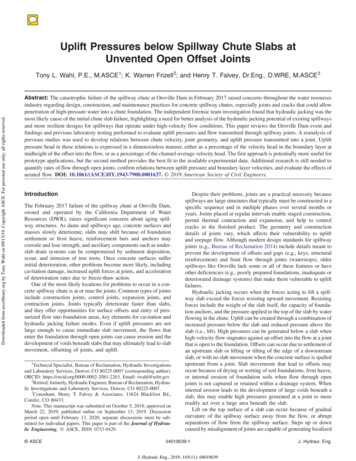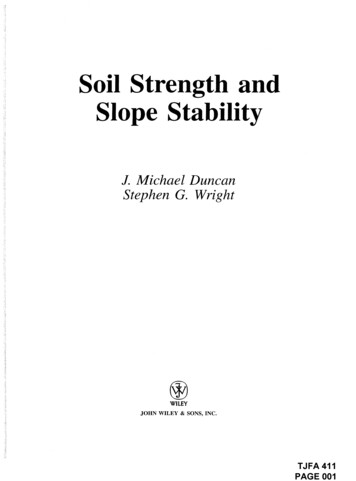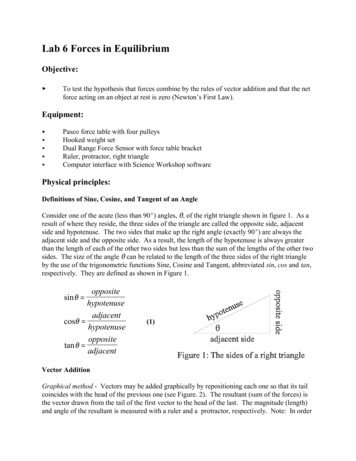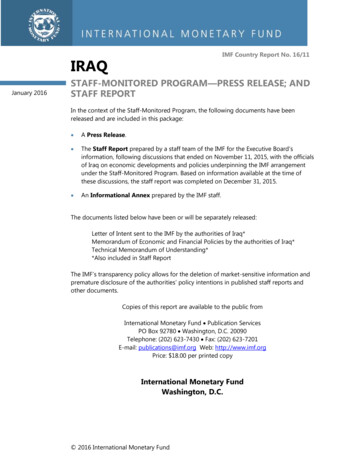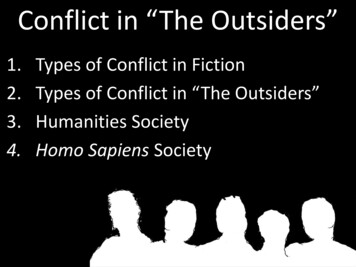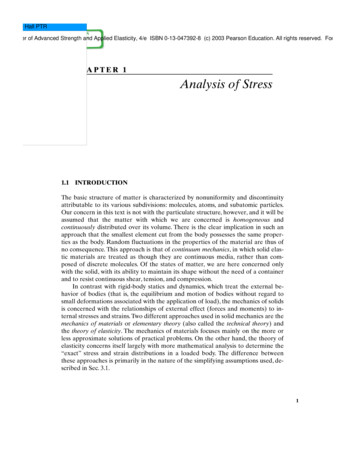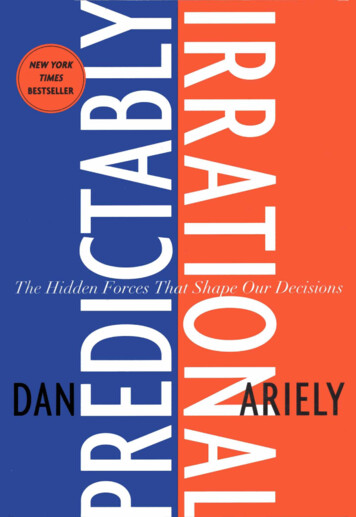
Transcription
USA 25.95CANADA 27.95 W h y do our headaches persist after taking a one-centaspirin but disappear when we take a 50-cent aspirin? Why does recalling the Ten Commandments reduce ourtendency to lie, even when we couldn't possibly becaught? W h y do we splurge on a lavish meal but cut couponsto save 25 cents on a can of soup? W h y do we go back for second helpings at the unlimitedbuffet, even when our stomachs are already full? And how did we ever start spending 4.15 on a cup ofcoffee when, just a few years ago, we used to pay lessthan a dollar?hen it comes to making decisions in our lives, wethink we're in control. We think we're makingsmart, rational choices. But are we?In a series o f illuminating, often surprising experi ments, M I T behavioral economist Dan Ariely refutes thecommon assumption that we behave in fundamentallyrational ways. Blending everyday experience with ground breaking research, Ariely explains how expectations,emotions, social norms, and other invisible, seeminglyillogical forces skew our reasoning abilities.N o t only do we make astonishingly simple mistakesevery day, but we make the same types of mistakes, Arielydiscovers. We consistently overpay, underestimate, andprocrastinate. We fail to understand the profound effectsof our emotions on what we want, and we overvalue whatwe already own. Yet these misguided behaviors are neitherrandom nor senseless. They're systematic and predict able—making us predictablyirrational.From drinking coffee to losing weight, from buying acar to choosing a romantic partner, Ariely explains howto break through these systematic patterns o f thought tomake better decisions. PredictablyIrrationalwill changethe way we interact with the world—one small decisionat a time.0208
DANARIELYis the Alfred P. Sloan Professor o fBehavioral E c o n o m i c s at M I T , where he holds a jointappointment between M I T ' s Media Laboratory and theSloan School of Management. He is also a researcher at theFederal Reserve B a n k of Boston and a visiting professorat Duke University. Ariely wrote this book while he wasa fellow at the Institute for Advance Study at Princeton.His work has been featured in leading scholarly journalsand a variety of popular media outlets, including the NewYorkTimes,the Wall Street Journal,Post, the ence.Ariely has appeared on C N N and National Public Radio.He divides his time between Durham, North Carolina,Cambridge, Massachusetts, and the rest o f the world.www.predictablyirrational.comA U T H O RP H O T O G R A P HJACKETDESIGNCOURTESYOF T H E A U T H O RBY CHRISTINEV A N BREEVisit www.AuthorTracker.com for exclusiveinformation on your favorite HarperCollins authors.HARPERAn ImprintofWzr erQoWxnsPublisherswww.harpercollins.com
PredictablyIrrational—it'snot what you think."A marvelous book that is both thought-provoking and highly entertaining, ranging fromthe power o f placebos to the pleasures o f Pepsi. Ariely unmasks the subtle but powerfultricks that our minds play on us, and shows us how we can prevent being fooled."—Jerome Groopman, Recanati Chair of Medicine, Harvard Medical School,and New York Times bestselling author o f How DoctorsThink" D a n Ariely is a genius at understanding human behavior: no economist does a betterjob of uncovering and explaining the hidden reasons for the weird ways we act, in themarketplace and out. PredictablyIrrationalwill reshape the way you see the world, andyourself, for good." — J a m e s Surowiecki, author o f The WisdomofCrowds"Filled with clever experiments, engaging ideas, and delightful anecdotes. D a n Arielyis a wise and amusing guide to the foibles, errors, and bloopers o f everyday decisionmaking." — D a n i e l G i l b e r t , Professor o f Psychology, Harvard University, andNewYork Timesbestselling author o f StumblingonHappiness" T h i s is going to be the most influential, talked-about b o o k in years. It is so full o f daz zling insights—and so engaging—that once I started reading, I couldn't put it down."— D a n i e l M c F a d d e n , 2 0 0 0 N o b e l Laureate in E c o n o m i c s ,M o r r i s C o x Professor o f E c o n o m i c s , University o f C a l i f o r n i a at Berkeley"PredictablyIrrationalis wildly original. It shows why—much more often than we usu ally care to admit—humans make foolish, and sometimes disastrous, mistakes. Arielynot only gives us a great read; he also makes us much wiser."— G e o r g e Akerlof, 2 0 0 1 N o b e l Laureate in E c o n o m i c s ,Koshland Professor o f E c o n o m i c s , University o f C a l i f o r n i a at Berkeley" T h e most difficult part o f investing is managing your emotions. D a n explains why thatis so challenging for all o f us, and how recognizing your built-in biases can help youavoid c o m m o n mistakes."— C h a r l e s Schwab, C h a i r m a n and C E O , T h e Charles S c h w a b C o r p o r a t i o n
predictablyirrational
predictablyirrationalThe Hidden ForcesOur DecisionsThatShapeDan ArielyHARPERAn om
PREDICTABLY IRRATIONAL. Copyright 2 0 0 8 by Dan Ariely. Allrights reserved. Printed in the United States of America. N o part of thisbook may be used or reproduced in any manner whatsoever withoutwritten permission except in the case of brief quotations embodied incritical articles and reviews. For information, address HarperCollinsPublishers, 10 East 53rd Street, New York, N Y 1 0 0 2 2 .HarperCollins books may be purchased for educational, business, orsales promotional use. For information, please write: Special MarketsDepartment, HarperCollins Publishers, 10 East 53rd Street, New York,N Y 10022.Designed by Renato StanisicLibrary of Congress Cataloging-in-Publication Data is available uponrequest.ISBN: 9 7 8 - 0 - 0 6 - 1 3 5 3 2 3 - 90809101112WBC/RRD109876
To my mentors, colleagues,who make researchandstudents—exciting
ContentsINTRODUCTION:How an Injury Led Me to IrrationalityResearchDescribedand to theHerexiCHAPTERIThe Truth about Relativity:Why Everything Is Relative—Even When It Shouldn't Be1CHAPTER2The Fallacy of Supply and Demand:Why the Price of Pearls—andEverythingElse—Is Up in the Air23CHAPTER 3The Cost of Zero Cost:Why We Often Pay Too Much When We Pay Nothing49
contentsCHAPTER4The Cost of Social Norms:Why We Are Happyto Do Things, but NotWe Are Paid to DoWhenThem67CHAPTER 5The Influence of Arousal:Why Hot Is Much HotterThan WeRealize89CHAPTER6The Problem of Procrastination and Self-Control:Why We Can't Make OurselvesDoWhat We Want to Do109CHAPTER7The High Price of Ownership:Why We OvervalueWhat We Have127CHAPTER 8Keeping Doors Open:Why Options Distract Us from Our Main Objective139CHAPTER 9The Effect of Expectations:Why the Mind Gets What It155viiiExpects
contentsCHAPTERIOThe Power of Price:Why a SO-Cent Aspirin Can Do What a PennyAspirinCan't173CHAPTER I IThe Context of Our Character, Part I:Why We Are Dishonest,andWhatWe Can Do about It195CHAPTER12The Context of Our Character, Part II:Why Dealing with Cash MakesUs MoreHonest217CHAPTER13Beer and Free Lunches:What Is BehavioralEconomics,the Freeand WhereLunches?231Thanks245List of Collaborators 249Notes 255Bibliography and Additional Readings 259Index 269ixAre
IntroductionHow an Injury Led Me to Irrationalityto the Research Described HereIandhave been told by many people that I have an unusual wayof looking at the world. Over the last 20 years or so of myresearch career, it's enabled me to have a lot of fun figuring outwhat really influences our decisions in daily life (as opposed towhat we think, often with great confidence, influences them).Do you know why we so often promise ourselves to diet,only to have the thought vanish when the dessert cart rollsby?Do you know why we sometimes find ourselves excitedlybuying things we don't really need?Do you know why we still have a headache after taking aone-cent aspirin, but why that same headache vanishes whenthe aspirin costs 50 cents?Do you know why people who have been asked to recallthe Ten Commandments tend to be more honest (at least im mediately afterward) than those who haven't? Or why honorcodes actually do reduce dishonesty in the workplace?
introductionBy the end of this book, you'll know the answers to theseand many other questions that have implications for yourpersonal life, for your business life, and for the way you lookat the world. Understanding the answer to the question aboutaspirin, for example, has implications not only for your choiceof drugs, but for one of the biggest issues facing our society:the cost and effectiveness of health insurance. Understandingthe impact of the Ten Commandments in curbing dishonestymight help prevent the next Enron-like fraud. And under standing the dynamics of impulsive eating has implicationsfor every other impulsive decision in our lives—includingwhy it's so hard to save money for a rainy day.My goal, by the end of this book, is to help you funda mentally rethink what makes you and the people around youtick. I hope to lead you there by presenting a wide range ofscientific experiments, findings, and anecdotes that are inmany cases quite amusing. Once you see how systematic cer tain mistakes are—how we repeat them again and again—Ithink you will begin to learn how to avoid some of them.But before I tell you about my curious, practical, enter taining (and in some cases even delicious) research on eating,shopping, love, money, procrastination, beer, honesty, andother areas of life, I feel it is important that I tell you aboutthe origins of my somewhat unorthodox worldview—andtherefore of this book. Tragically, my introduction to thisarena started with an accident many years ago that was any thing but amusing.O N WHAT W O U L Dotherwise have been a normal Friday after noon in the life of an eighteen-year-old Israeli, everythingchanged irreversibly in a matter of a few seconds. An exploxii
introductionsion of a large magnesium flare, the kind used to illuminatebattlefields at night, left 70 percent of my body covered withthird-degree burns.The next three years found me wrapped in bandages in ahospital and then emerging into public only occasionally,dressed in a tight synthetic suit and mask that made me looklike a crooked version of Spider-Man. Without the ability toparticipate in the same daily activities as my friends and fam ily, I felt partially separated from society and as a conse quence started to observe the very activities that were oncemy daily routine as if I were an outsider. As if I had comefrom a different culture (or planet), I started reflecting on thegoals of different behaviors, mine and those of others. Forexample, I started wondering why I loved one girl but notanother, why my daily routine was designed to be comfort able for the physicians but not for me, why I loved going rockclimbing but not studying history, why I cared so much aboutwhat other people thought of me, and mostly what it is aboutlife that motivates people and causes us to behave as we do.During the years in the hospital following my accident, I hadextensive experience with different types of pain and a greatdeal of time between treatments and operations to reflect on it.Initially, my daily agony was largely played out in the "bath," aprocedure in which I was soaked in disinfectant solution, thebandages were removed, and the dead particles of skin werescraped off. When the skin is intact, disinfectants create a lowlevel sting, and in general the bandages come off easily. Butwhen there is little or no skin—as in my case because of myextensive burns—the disinfectant stings unbearably, the ban dages stick to the flesh, and removing them (often tearing them)hurts like nothing else I can describe.Early on in the burn department I started talking to thexiii
introductionnurses who administered my daily bath, in order to under stand their approach to my treatment. The nurses wouldroutinely grab hold of a bandage and rip it off as fast as pos sible, creating a relatively short burst of pain; they would re peat this process for an hour or so until they had removedevery one of the bandages. Once this process was over I wascovered with ointment and with new bandages, in order torepeat the process again the next day.The nurses, I quickly learned, had theorized that a vigor ous tug at the bandages, which caused a sharp spike of pain,was preferable (to the patient) to a slow pulling of the wrap pings, which might not lead to such a severe spike of pain butwould extend the treatment, and therefore be more painfuloverall. T h e nurses had also concluded that there was no dif ference between two possible methods: starting at the mostpainful part of the body and working their way to the leastpainful part; or starting at the least painful part and advanc ing to the most excruciating areas.As someone who had actually experienced the pain of thebandage removal process, I did not share their beliefs (whichhad never been scientifically tested). Moreover, their theoriesgave no consideration to the amount of fear that the patientfelt anticipating the treatment; to the difficulties of dealingwith fluctuations of pain over time; to the unpredictability ofnot knowing when the pain will start and ease off; or to thebenefits of being comforted with the possibility that the painwould be reduced over time. But, given my helpless position,I had little influence over the way I was treated.As soon as I was able to leave the hospital for a prolongedperiod (I would still return for occasional operations andtreatments for another five years), I began studying at TelAviv University. During my first semester, I took a class thatxiv
introductionprofoundly changed my outlook on research and largely de termined my future. This was a class on the physiology ofthe brain, taught by professor Hanan Frenk. In addition to thefascinating material Professor Frenk presented about the work ings of the brain, what struck me most about this class washis attitude to questions and alternative theories. Many times,when I raised my hand in class or stopped by his office tosuggest a different interpretation of some results he had pre sented, he replied that my theory was indeed a possibility(somewhat unlikely, but a possibility nevertheless)—and wouldthen challenge me to propose an empirical test to distinguishit from the conventional theory.Coming up with such tests was not easy, but the idea thatscience is an empirical endeavor in which all the participants,including a new student like myself, could come up with al ternative theories, as long as they found empirical ways totest these theories, opened up a new world to me. On one ofmy visits to Professor Frenk's office, I proposed a theory ex plaining how a certain stage of epilepsy developed, and in cluded an idea for how one might test it in rats.Professor Frenk liked the idea, and for the next threemonths I operated on about 50 rats, implanting catheters intheir spinal cords and giving them different substances tocreate and reduce their epileptic seizures. One of the practi cal problems with this approach was that the movements ofmy hands were very limited, because of my injury, and as aconsequence it was very difficult for me to operate on therats. Luckily for me, my best friend, Ron Weisberg (an avidvegetarian and animal lover), agreed to come with me to thelab for several weekends and help me with the procedures—atrue test of friendship if ever there was one.In the end, it turned out that my theory was wrong, butxv
introductionthis did not diminish my enthusiasm. I was able to learnsomething about my theory, after all, and even though thetheory was wrong, it was good to know this with high cer tainty. I always had many questions about how things workand how people behave, and my new understanding—thatscience provides the tools and opportunities to examine any thing I found interesting—lured me into the study of howpeople behave.With these new tools, I focused much of my initial effortson understanding how we experience pain. For obvious rea sons I was most concerned with such situations as the bathtreatment, in which pain must be delivered to a patient over along period of time. Was it possible to reduce the overall ag ony of such pain? Over the next few years I was able to carryout a set of laboratory experiments on myself, my friends,and volunteers—using physical pain induced by heat, coldwater, pressure, loud sounds, and even the psychological painof losing money in the stock market—to probe for the an swers.By the time I had finished, I realized that the nurses in theburn unit were kind and generous individuals (well, therewas one exception) with a lot of experience in soaking andremoving bandages, but they still didn't have the right theoryabout what would minimize their patients' pain. How couldthey be so wrong, I wondered, considering their vast experi ence? Since I knew these nurses personally, I knew that theirbehavior was not due to maliciousness, stupidity, or neglect.Rather, they were most likely the victims of inherent biases intheir perceptions of their patients' pain—biases that appar ently were not altered even by their vast experience.For these reasons, I was particularly excited when I re turned to the burn department one morning and presentedxvi
introductionmy results, in the hope of influencing the bandage removalprocedures for other patients. It turns out, I told the nursesand physicians, that people feel less pain if treatments (suchas removing bandages in a bath) are carried out with lowerintensity and longer duration than if the same goal isachieved through high intensity and a shorter duration. Inother words, I would have suffered less if they had pulledthe bandages off slowly rather than with their quick-pullmethod.The nurses were genuinely surprised by my conclusions,but I was equally surprised by what Etty, my favorite nurse,had to say. She admitted that their understanding had beenlacking and that they should change their methods. But shealso pointed out that a discussion of the pain inflicted in thebath treatment should also take into account the psychologi cal pain that the nurses experienced when their patientsscreamed in agony. Pulling the bandages quickly might bemore understandable, she explained, if it were indeed thenurses' way of shortening their own torment (and their facesoften did reveal that they were suffering). In the end, though,we all agreed that the procedures should be changed, andindeed, some of the nurses followed my recommendations.My recommendations never changed the bandage removalprocess on a greater scale (as far as I know), but the episodeleft a special impression on me. If the nurses, with all their ex perience, misunderstood what constituted reality for the pa tients they cared so much about, perhaps other people similarlymisunderstand the consequences of their behaviors and, forthat reason, repeatedly make the wrong decisions. I decided toexpand my scope of research, from pain to the examination ofcases in which individuals make repeated mistakes—withoutbeing able to learn much from their experiences.xvii
introductionT H I S J O U R N E Y INTOthe many ways in which we are all ir rational, then, is what this book is about. T h e disciplinethat allows me to play with this subject matter is calledbehavioraleconomics,or judgment and decision making(JDM).Behavioral economics is a relatively new field, one thatdraws on aspects of both psychology and economics. It hasled me to study everything from our reluctance to save forretirement to our inability to think clearly during sexualarousal. It's not just the behavior that I have tried to under stand, though, but also the decision-making processes behindsuch behavior—yours, mine, and everybody else's. BeforeI go on, let me try to explain, briefly, what behavioral eco nomics is all about and how it is different from standardeconomics. Let me start out with a bit of Shakespeare:What a piece of work is a man! how noble inhow infinite in faculty! in form and movingexpressand admirable!in apprehensionreason!howin action how like an angel!how like a god! The beauty of theworld, the paragonof animals.—from Act II,scene 2 , of HamletThe predominant view of human nature, largely sharedby economists, policy makers, nonprofessionals, and every day Joes, is the one reflected in this quotation. O f course,this view is largely correct. Our minds and bodies are capableof amazing acts. We can see a ball thrown from a distance,instantly calculate its trajectory and impact, and then moveour body and hands in order to catch it. We can learn newlanguages with ease, particularly as young children. We canmaster chess. We can recognize thousands of faces withoutxviii
introductionconfusing them. We can produce music, literature, technol ogy, and art—and the list goes on and on.Shakespeare is not alone in his appreciation for the hu man mind. In fact, we all think of ourselves along the lines ofShakespeare's depiction (although we do realize that ourneighbors, spouses, and bosses do not always live up to thisstandard). Within the domain of science, these assumptionsabout our ability for perfect reasoning have found their wayinto economics. In economics, this very basic idea, called ra tionality provides the foundation for economic theories, pre dictions, and recommendations.From this perspective, and to the extent that we all believein human rationality, we are all economists. I don't mean thateach of us can intuitively develop complex game-theoreticalmodels or understand the generalized axiom of revealed pref erence (GARP); rather, I mean that we hold the basic beliefsabout human nature on which economics is built. In this book,when I mention the rationaleconomic model, I refer to thebasic assumption that most economists and many of us holdabout human nature—the simple and compelling idea that weare capable of making the right decisions for ourselves.Although a feeling of awe at the capability of humans isclearly justified, there is a large difference between a deepsense of admiration and the assumption that our reasoningabilities are perfect. In fact, this book is about humannality—aboutirratio our distance from perfection. I believe thatrecognizing where we depart from the ideal is an importantpart of the quest to truly understand ourselves, and one thatpromises many practical benefits. Understanding irrational ity is important for our everyday actions and decisions, andfor understanding how we design our environment and thechoices it presents to us.xix
introductionMy further observation is that we are not only irrational,but predictablyirrational—thatour irrationality happensthe same way, again and again. Whether we are acting asconsumers, businesspeople, or policy makers, understandinghow we are predictably irrational provides a starting pointfor improving our decision making and changing the way welive for the better.This leads me to the real "rub" (as Shakespeare mighthave called it) between conventional economics and behav ioral economics. In conventional economics, the assumptionthat we are all rational implies that, in everyday life, we com pute the value of all the options we face and then follow thebest possible path of action. What if we make a mistake anddo something irrational? Here, too, traditional economicshas an answer: "market forces" will sweep down on us andswiftly set us back on the path of righteousness and rational ity. On the basis of these assumptions, in fact, generations ofeconomists since Adam Smith have been able to develop farreaching conclusions about everything from taxation andhealth-care policies to the pricing of goods and services.But, as you will see in this book, we are really far less ra tional than standard economic theory assumes. Moreover,these irrational behaviors of ours are neither random norsenseless. They are systematic, and since we repeat themagain and again, predictable. So, wouldn't it make sense tomodify standard economics, to move it away from naivepsychology (which often fails the tests of reason, introspec tion, and—most important—empirical scrutiny)? This isexactly what the emerging field of behavioral economics,and this book as a small part of that enterprise, is trying toaccomplish.xx
introductionAsYOU W I L Lsee in the pages ahead, each of the chapters inthis book is based on a few experiments I carried out over theyears with some terrific colleagues (at the end of the book, Ihave included short biographies of my amazing collabora tors) . Why experiments ? Life is complex, with multiple forcessimultaneously exerting their influences on us, and this com plexity makes it difficult to figure out exactly how each ofthese forces shapes our behavior. For social scientists, experi ments are like microscopes or strobe lights. They help us slowhuman behavior to a frame-by-frame narration of events,isolate individual forces, and examine those forces carefullyand in more detail. They let us test directly and unambigu ously what makes us tick.There is one other point I want to emphasize about ex periments. If the lessons learned in any experiment werelimited to the exact environment of the experiment, theirvalue would be limited. Instead, I would like you to thinkabout experiments as an illustration of a general principle,providing insight into how we think and how we makedecisions—not only in the context of a particular experi ment but, by extrapolation, in many contexts of life.In each chapter, then, I have taken a step in extrapolatingthe findings from the experiments to other contexts, attempt ing to describe some of their possible implications for life,business, and public policy. The implications I have drawnare, of course, just a partial list.To get real value from this, and from social science in gen eral, it is important that you, the reader, spend some timethinking about how the principles of human behavior identi fied in the experiments apply to your life. My suggestion toyou is to pause at the end of each chapter and considerxxi
introductionwhether the principles revealed in the experiments mightmake your life better or worse, and more importantly whatyou could do differently, given your new understanding ofhuman nature. This is where the real adventure lies.And now for the journey.xxii
predictablyirrational
C H A P T E R1The Truth about RelativityWhy Everything Is Relative—EvenWhen It Shouldn't Bene day while browsing the World Wide Web (obviouslyfor work—not just wasting time), I stumbled on the fol lowing ad, on the Web site of a magazine, theEconomist.comOPINIONWORLDBUSINESSFINANCE & ECONOMICSEconomist.SUBSCRIPTIONSWelcome toThe Economist Subscription CentrePick the type of subscription you want to buyor renew.SCIENCE & TECHNOLOGYPEOPLEBOOKS & ARTSM A R K E T S & DATADIVERSIONS Economist.com subscription - US 59.00One-year subscription to Economist.com.Includes online access to all articles fromThe Economist since 1997. Print subscription - US 125.00One-year subscription to the print editionof The Economist. Print & web subscription - US 125.00One-year subscription to the print editionof The Economist and online access to allarticles from The Economist since 1997.
predictably irrationalI read these offers one at a time. The first offer—the Inter net subscription for 59—seemed reasonable. The secondoption—the 125 print subscription—seemed a bit expen sive, but still reasonable.But then I read the third option: a print and Internet sub scription for 125.1 read it twice before my eye ran back to theprevious options. Who would want to buy the print optionalone, I wondered, when both the Internet and the print sub scriptions were offered for the same price? Now, the print-onlyoption may have been a typographical error, but I suspect thatthe clever people at the Economist'sLondon offices (and theyare clever—and quite mischievous in a British sort of way) wereactually manipulating me. I am pretty certain that they wantedme to skip the Internet-only option (which they assumed wouldbe my choice, since I was reading the advertisement on the Web)and jump to the more expensive option: Internet and print.But how could they manipulate me? I suspect it's becausethe Economist'smarketing wizards (and I could just picturethem in their school ties and blazers) knew something impor tant about human behavior: humans rarely choose things inabsolute terms. We don't have an internal value meter thattells us how much things are worth. Rather, we focus on therelative advantage of one thing over another, and estimatevalue accordingly. (For instance, we don't know how much asix-cylinder car is worth, but we can assume it's more expen sive than the four-cylinder model.)In the case of the Economist,I may not have known whetherthe Internet-only subscription at 59 was a better deal than theprint-only option at 125. But I certainly knew that the printand-Internet option for 125 was better than the print-onlyoption at 125. In fact, you could reasonably deduce that inthe combination package, the Internet subscription is free! "It's2
the truth about relativitya bloody steal—go for it, governor! " I could almost hear themshout from the riverbanks of the Thames. And I have to admit,if I had been inclined to subscribe I probably would have takenthe package deal myself. (Later, when I tested the offer on alarge number of participants, the vast majority preferred theInternet-and-print deal.)So what was going on here? Let me start with a funda mental observation: most people don't know what they wantunless they see it in context. We don't know what kind ofracing bike we want—until we see a champ in the Tour deFrance ratcheting the gears on a particular model. We don'tknow what kind of speaker system we like—until we hear aset of speakers that sounds better
"Dan Ariely is a genius at understanding human behavior: no economist does a better job of uncovering and explaining the hidden reasons for the weird ways we act, in the marketplace and out. Predictably Irrational will reshape the way you see the world, and yourself, for


